Customer Satisfaction Surveys: A Definitive Guide
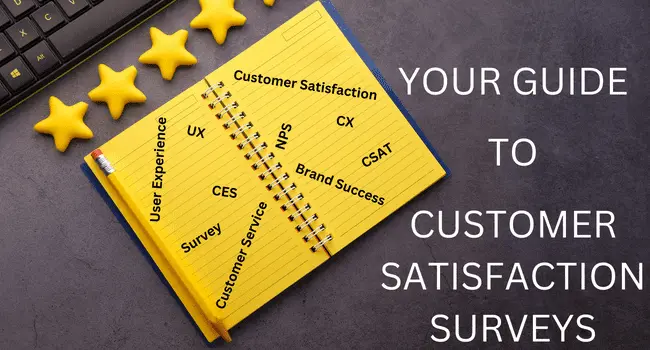
Customer experience(CX), whether it be support experience, purchase experience, or product experience, is fundamental for the success of businesses.
In fact, evidence suggests that CX has become as important (if not more) as product and pricing.
Some Statistics
SuperOffice asked 1,920 business professionals what their top business priority was for the following 5 years. And 45.9% answered customer experience, while 33.6% answered product, and 20.5% answered pricing.
Hiver's study "Customer Support Through The Eyes of Consumers in 2020" suggested that "60% of customers would switch to an alternate brand after just 2 or 3 bad experiences, and 30% would switch to an alternate brand right after just one bad support experience." Well, that's rather tough, isn't it?
A research study from American Express indicated that "86% of customers are willing to pay more for a better experience."
Well, it seems the data from Walker's report suggesting that "customer experience will overtake price and product as the key brand differentiator by the end of 2020" was on point.
But okay, enough with the data for now. Customer experience is clearly key for success, and no wonder.
I mean, think about it. Product functionality and suitable pricing are of course crucial for users; but isn't it as crucial to, say, have your specific needs met smoothly and easily, or have a great conversation with a polite and truly helpful support agent, or have your support tickets solved effectively and on time, or, you know, not get lost in and overwhelmed by the brand in general?
Those are all elements of a good customer experience.
So, we want to provide the best possible experience to all our customers, in other words, we want to make and keep our customers satisfied with our services. And for this purpose, we need to constantly measue customer satisfaction, which is achieved when what our brand offers meets the expectations of our customers.
But how do we measure customer satsifaction? Well, that's what I'm going to cover in this article: we do it via customer satisfaction surveys.
The article will cover the following:
- What is a customer satisfaction survey?
- 3 common types of customer satisfaction surveys: CSAT, NPS, and CES surveys.
- How to calculate CSAT, NPS, and CES.
- Tips on how to implement customer satisfaction surveys.
- How to create and share customer satisfaction surveys via FormPress App.
What is a Customer Satisfaction Survey?
Customer satisfaction surveys are tools that help businesses get feedback from customers about their thoughts and feelings on the product, support, user experience(UX), and brand in general. So, basically, customer satisfaction surveys are crucial feedback collectors that businesses heavily rely on for maintained success.
A customer satisfaction survey typically includes only one or just a few question(s), but of course, it could be longer. However, there are advantages and disadvantages to either a very short, or somewhat long survey. We'll get to that later.
3 Most Common Types of Customer Satisfaction Surveys
There are a number of customer satisfaction survey types, but in the broad analysis, almost all of them fall under 3 main categories: Customer Satisfaction(CSAT) Survey, Net Promoter Score(NPS) Survey, and Customer Effort Score(CES) Survey.
Customer Satisfaction (CSAT) Survey
First of all, let me mention a confusing fact about the term "customer satisfaction survey". Well, this term refers both to a specific type of customer satisfaction surveys(which I will refer to as "CSAT Survey" from now on), and is the general name for all such surveys which collect information about customer satisfaction.
Complicated? Well, tell me about it…
Okay though, where were we? Oh right, CSAT surveys.
A CSAT survey measures CSAT score. It asks how satisfied a user was with a product, service, transaction, a process like support request, or overall experience. So, the survey can be used both for a short-term and specific experience, and a general one.
It asks a variant of the question "How satisfied are you with our services?"
I must say, there doesn't seem to be a universal agreement on how to create and use a CSAT survey.
So, depending on your policies, you can use a binary scale question like "Yes/No, Happy-Face/Sad-Face, Thumbs-Up/Thumbs-Down", a rating scale question(1-to-5, 1-to-7), or even a question like "Happy-Face/Neutral-Face/Sad-Face".
Here are some examples:
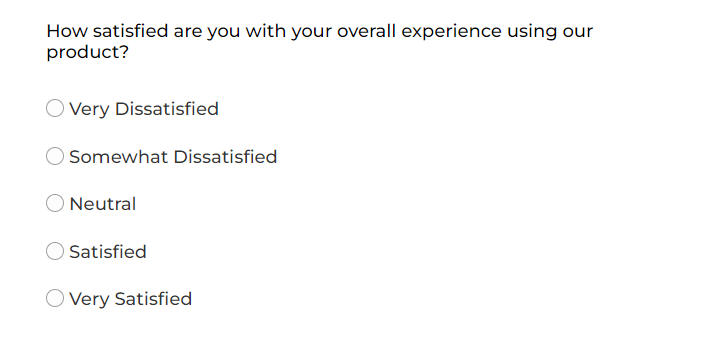

Now, let's look at how to calculate your CSAT score.
Remember, this calculation may slightly change depending on what type of a question you ask in your CSAT survey. But the main idea is the same, and it's very simple:
Take the number of satisfied customers, divide it by the total number of respondents, and finally, multiply the result by 100. Done!
For example, let's say you ask the below rating scale question in your CSAT survey.
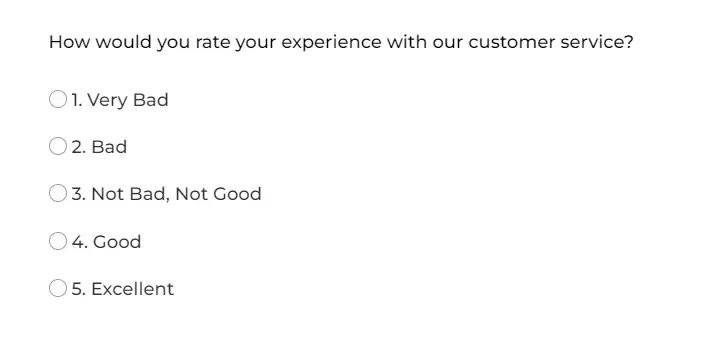
In this case, those who pick the options 4 and 5 would be considered satisfied customers. Let's say you have a total of 150 customers who took this survey, and 30 of them answered either 4 or 5.
Then: 30/150= .2, .2x100= 20 would be your CSAT score. See? Pretty easy.
Net Promoter Score(NPS) Survey
Compared to a CSAT survey, a net promoter score(NPS) survey is not much complicated as it has a universally accepted method of application. The survey's main aim is to determine the degree of customer loyalty.
It measures net promoter score(NPS) and asks the very typical question "How likely would you be to recommend out product/services to a friend or colleague?"
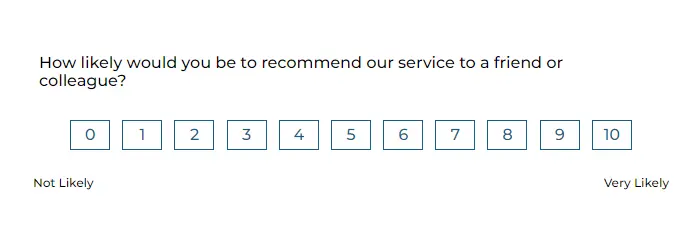
The survey offers a scale from 0-to-10. Those who answer 0-to-6 are detractors, those who answer 7 or 8 are passives, and those who answer 9 or 10 are promoters.
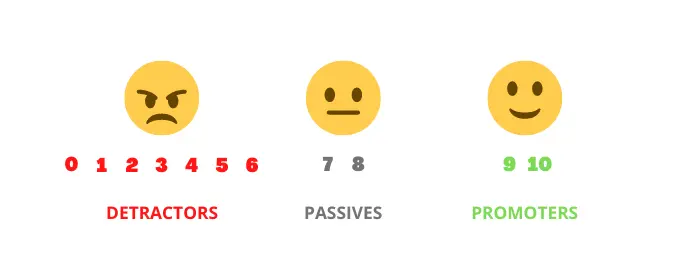
- Detractors are considered to be customers who are not satisfied with your services, are likely to leave, or worse, share their bad experiences with others.
- Passives are considered to be customers who are kind of in the middle, not satisfied enough to recommend your brand to others or remain as loyal customers, but also not exactly unsatisfied to the degree that they would leave or spread bad word of mouth. They are considered both close to becoming detractors(especially those who answer 7), and to becoming promoters(especially those who answer 8).
- Promoters are considered to be your most loyal customers who are truly satisfied with your services. The more of them you have, the better.
And finally, NPS calculation is straightforward: The percentage of promoters - the percentage of detractors= Your Net Promoter Score
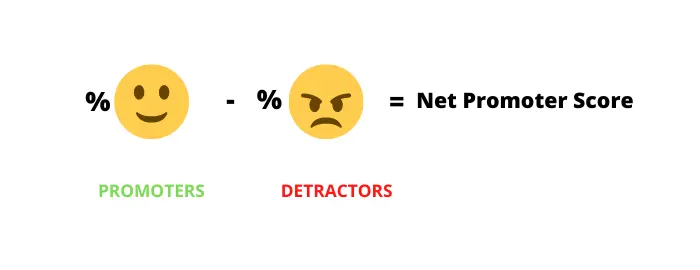
For example, %70 of your respondents scored you either 9 or 10(thus are promoters), and %30 of them scored you 6 or lower(thus are detractors).
Then: 70-30= 40 would be your NPS. Again, easy calculation!
By the way! If you want to learn more about NPS and NPS surveys, check out this article!
Customer Effort Score(CES) Survey
As the name suggests, customer effort score(CES) surveys measure how much effort it took a customer to complete an action in your product, customer service, or any specific process. In other words, a CES survey asks how easy something was for your customers.
So, a typical question would be "How easy was it for you to complete your purchase?"(rating scale question), or "Was it easy for you to get the help you needed?(binary scale question).
Here are some examples:
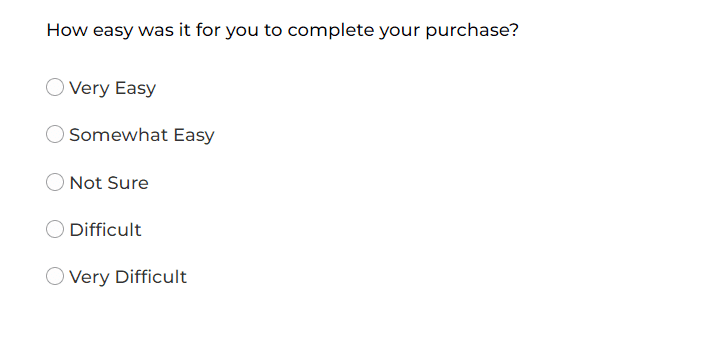

Like a CSAT survey and unlike an NPS survey, a CES survey can be created in a variety of ways depending on what type of a question you ask.
However, if you want to be able to calculate your CES, then you need to use a rating scale question. Or, you at least need to be able to give scores to the answers, and the best way for that is via a rating scale question.
Okay, let's get to the calculation of CES. In theory, it's pretty basic. To calculate CES, you just have to take the average of all the scores. So:
Sum of all customer effort scores/total number of respondents= your customer effort score.
But things will get complicated in a bit. Let's first look at an example.
Suppose you ask the below CES question to a total of 50 customers.
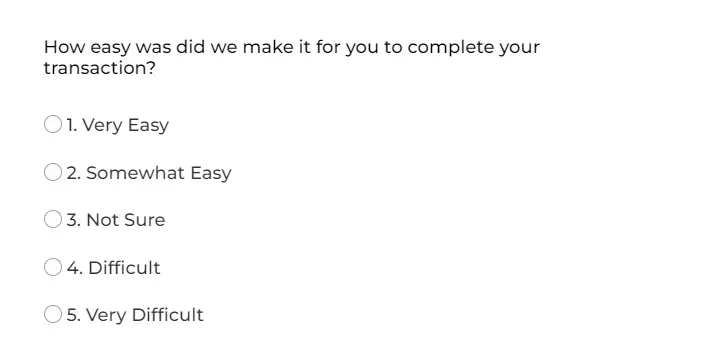
20 of your respondents answered 5, 10 of them answered 3, and 20 of then answered 2.
Then: 20x5= 100, 10x3= 30, 20x2= 40. 100+30+40= 170, 170/50= 3.4(out of 5) would be your CES.
But here's the thing: is 3.4 good or bad? How do we evaluate? Well, it depends.
This is a good time to stress the importance of consistency in how you structure your rating scale questions. If 1 is "very easy" and 5 is "very difficult", then 3.4 would be negative CES. But if 1 is "very difficult" and 5 is "very easy", then 3.4 would be positive CES.
So, in our example, 3.4 would be bad.
Tips on Customer Satisfaction Survey Implementation
Well, it is important to implement the right customer satisfaction survey at the right time and in the right place.
When, Where, and How
Before we look at how, let's talk about when and where.
When
For a start, all the three customer satisfaction surveys I mentioned ask questions that can only be accurately answered after some time, experience, or interactive process. So, it wouldn't be ideal to implement the surveys at the beginning stages of a customer's journey.
Especially a customer loyalty survey like NPS survey should not be implemented until the user has had enough experience with the product/service. Ideally, it should be at least 2-to-3 months into a users journey before you offer them an NPS survey.
Similarly, a CSAT survey asking customers how satisfied they are with their overall experiences should take some time before implementation. But if it's a more specific CSAT survey with a question like "How satisfied were you with the live support you received?", then it's totally fine. As long as there is a clear action like live support interaction, ticket closure, or product use, then a CSAT survey can be implemented right when the process is complete.
Again, a CES survey can be implemented right after an evaluable process like when a support ticket has been completed.
Where
An NPS survey, or a CSAT survey which asks about overall experience can generally be implemented in your main webpage.
Whereas a CES survey, or a CSAT survey which asks about a specific experience should generally be implemented on the page where the action in question is completed.
How
There are a number of ways you can implement your customer satisfaction surveys.
Here are some:
- You can embed them into your webpages as widgets. For example, a "Give Us Feedback!" button can appear at the bottom-right of your page. Upon clicking on it, users can see and fill out the survey directly.
- You can embed the surveys into your webpages as pop-ups. For example, when a user lands on an after-purchase thank you page, a CES survey asking "how easy it was to complete the transaction" can appear as pop-up.
- You can embed the surveys into your webpages directly. On your main webpage, you can embed the survey such that only the first question will be visible to users, and a click on the question will take them to your surveys page.
- You can share your surveys with your customers via e-mail, WhatsApp, or SMS.
Survey Length
Remember when I said "we'll get to that later" about short and long surveys? Well, here we are.
You can of course combine several customer satisfaction surveys to create a more comprehensive survey, but it's not always ideal to do so.
Yes, an all-in-one survey would allow you to gather the information all at once, but it would come with a cost. As you probably know, our attention spans and boredom limits are not in their best shapes nowadays. So, a long survey will probably increase abandonment, which is not good, at all.
Plus, you most likely have one or two follow-up questions to your main one already. Add the other survey questions to that? Whoah! That's a lot of questions.
Of course, it's good to send out long comprehensive surveys to your customers every now and then; but it's generally ideal to keep your customer satisfaction surveys separated, and ask one main question in each.
How to Create/Share Customer Satisfaction Surveys via FormPress App
Here comes my favourite part! "How to do it" with FormPress.
First of all, you can easily create your survey with our form-builder.
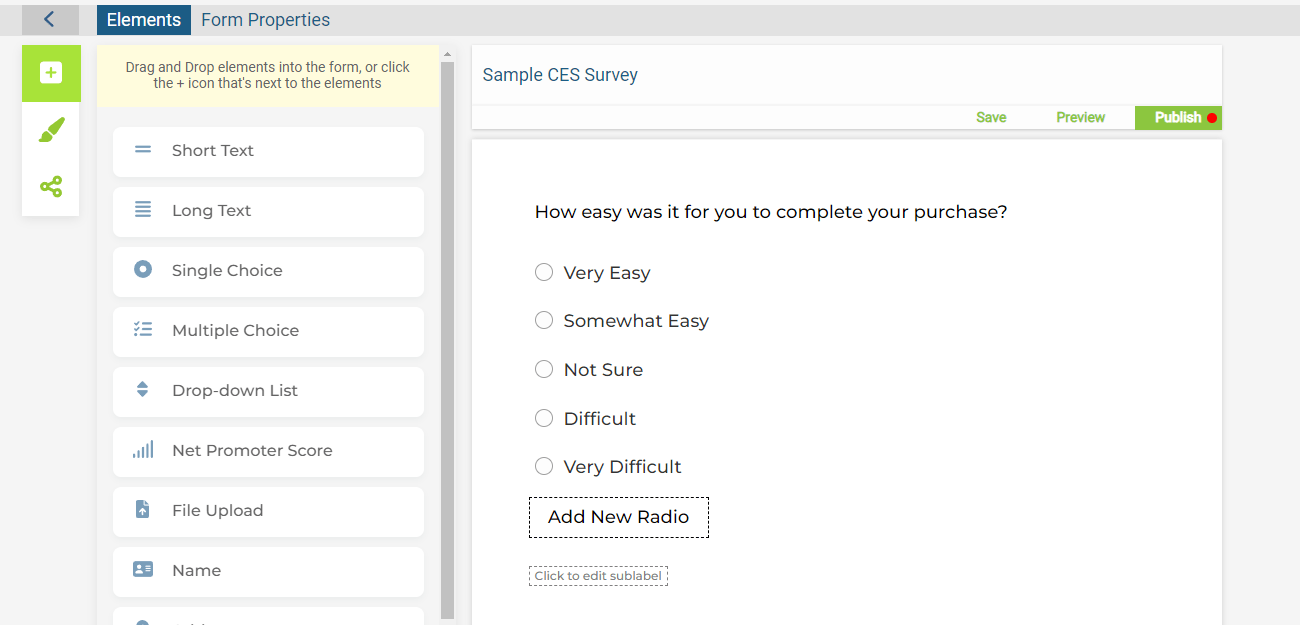
Once you save and publish your survey, you have several options to share it.

On the share page of FormPress App:
- You can copy and share the URL of your survey.
- You can copy the embed code of your survey, paste it into the html file of your webpage, and present your survey there.
- Or, you can set up the survey as a widget, then copy and paste the embed code into the html file of your webpage, and voila! Widget ready!
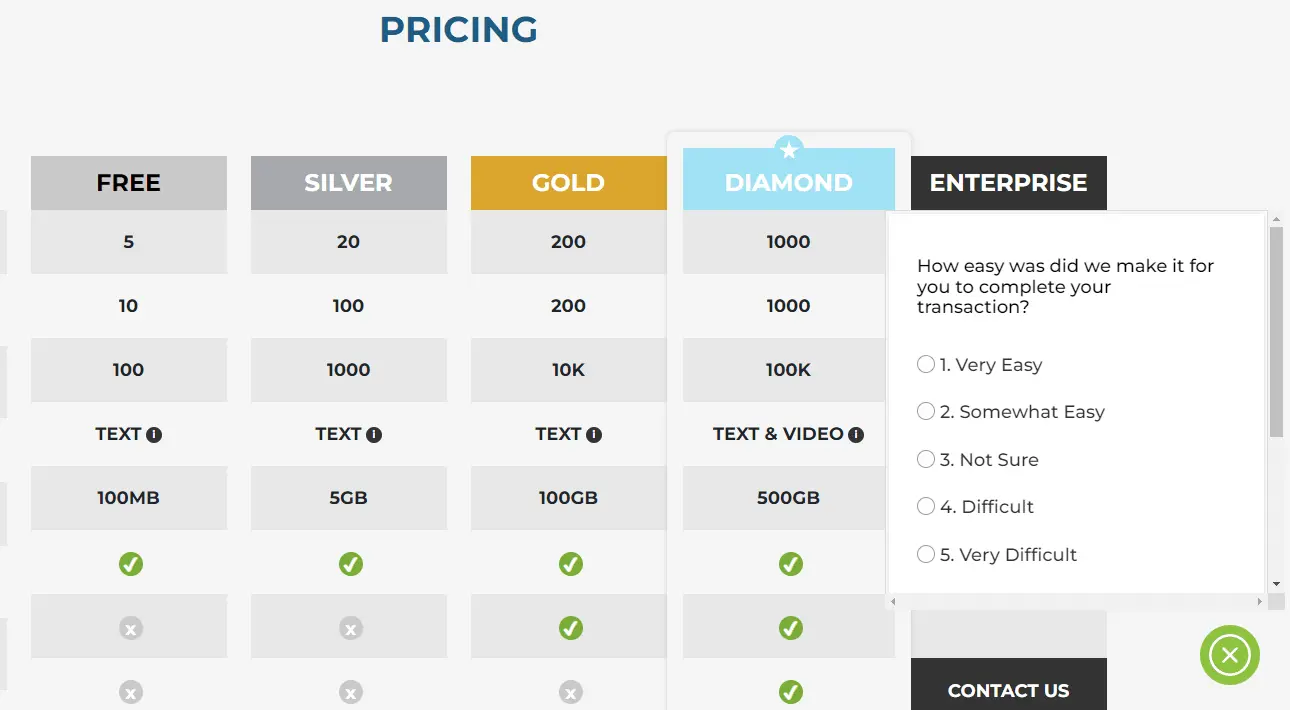
Final Word
It's crystal clear that customer experience and satisfaction are bedrocks for a successful business, and customer satisfaction surveys are indespensable tools to measure satisfaction and improve CX to the best possible!
For more related content, feel free to check FormPress Blog.

